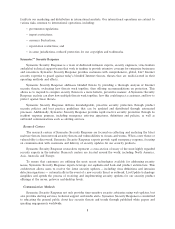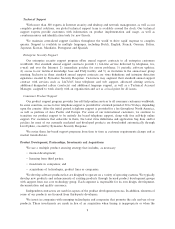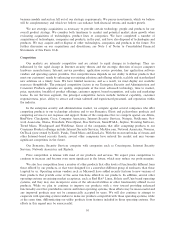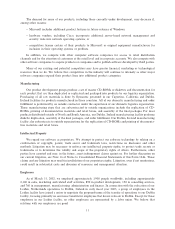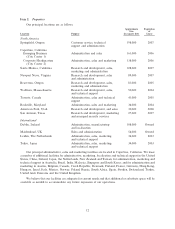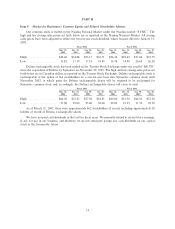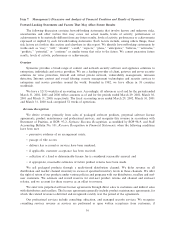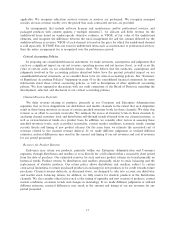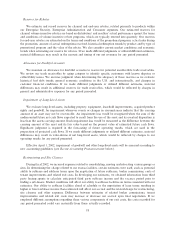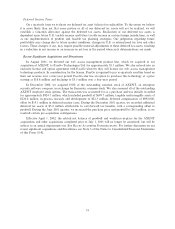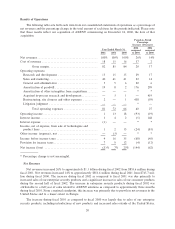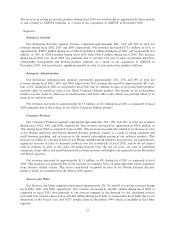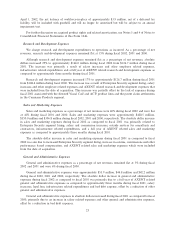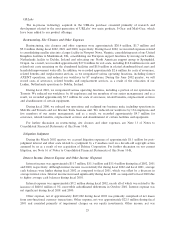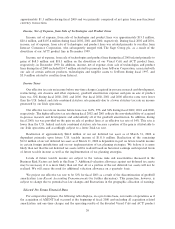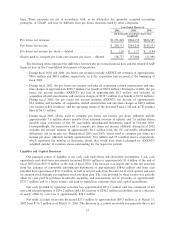Symantec 2002 Annual Report Download - page 39
Download and view the complete annual report
Please find page 39 of the 2002 Symantec annual report below. You can navigate through the pages in the report by either clicking on the pages listed below, or by using the keyword search tool below to find specific information within the annual report.applicable. We recognize education services revenue as services are performed. We recognize managed
security services revenue ratably over the period that such contracted services are provided.
In arrangements that include software licenses and maintenance and/or professional services, and
packaged products with content updates (""multiple elements''), we allocate and defer revenue for the
undelivered items based on vendor-speciÑc objective evidence, or VSOE, of fair value of the undelivered
elements, and recognize the diÅerence between the total arrangement fee and the amount deferred for the
undelivered items as revenue. VSOE of each element is based on the price for which the undelivered element
is sold separately. If VSOE does not exist for undelivered items such as maintenance or professional services,
then the entire arrangement fee is recognized over the performance period.
Critical Accounting Policies
In preparing our consolidated Ñnancial statements, we make estimates, assumptions and judgments that
can have a signiÑcant impact on our net revenue, operating income and net income (loss), as well as on the
value of certain assets on our consolidated balance sheet. We believe that the estimates, assumptions and
judgments involved in the accounting policies described below have the greatest potential impact on our
consolidated Ñnancial statements, so we consider these to be our critical accounting policies. See ""Summary
of SigniÑcant Accounting Policies'' beginning on page 50 in the consolidated Ñnancial statements for more
information about these critical accounting policies, as well as descriptions of other signiÑcant accounting
policies. We have engaged in discussions with our audit committee of the Board of Directors regarding the
development, selection and disclosure of our critical accounting policies.
Channel Revenue Deferrals
We defer revenue relating to products, primarily in our Consumer and Enterprise Administration
segments, that we have shipped into our distribution and reseller channels to the extent that such shipments
result in there being inventory in excess of certain speciÑed inventory levels for these channels. We defer this
revenue as an oÅset to accounts receivable. We estimate the excess of inventory levels in these channels by
analyzing channel inventory level and distribution sell-through trends obtained from our channel partners, as
well as various historical trends on a product basis. In addition, we consider other factors in assessing these
speciÑed inventory levels, such as product seasonality, current market conditions, economic trends, existing
security threats and timing of new product releases. On the same basis, we estimate the associated cost of
revenues related to the channel revenue deferral. If we made diÅerent judgments or utilized diÅerent
estimates, material diÅerences may result in the amount and timing of our net revenues and cost of revenues
for any period presented.
Reserves for Product Returns
End-users may return our products, primarily within our Enterprise Administration and Consumer
segments, through distributors and resellers or to us directly for a full refund within a reasonably short period
from the date of purchase. Our estimated reserves for such end-user product returns are based primarily on
historical trends. Product returns by distributors and resellers principally relate to stock balancing and the
replacement of obsolete products. Our return policy allows distributors and resellers, subject to certain
contractual limitations, to return purchased products in exchange for new products or for credit towards future
purchases. Channel revenue deferrals, as discussed above, are designed to take into account any distributor
and reseller stock balancing returns. In addition, we fully reserve for obsolete products in the distribution
channels. We also consider other factors such as the timing of upgrades and new versions of products, current
market conditions, economic trends and changes in technology. If we made diÅerent judgments or utilized
diÅerent estimates, material diÅerences may result in the amount and timing of our net revenues for any
period presented.
17



